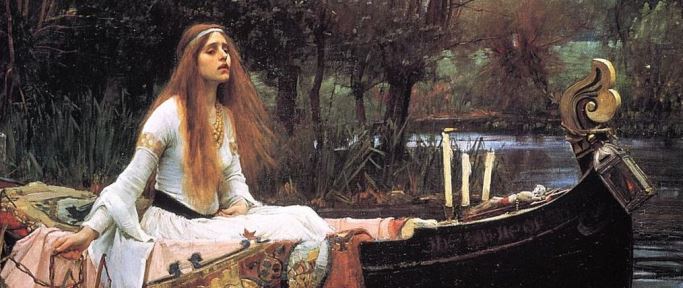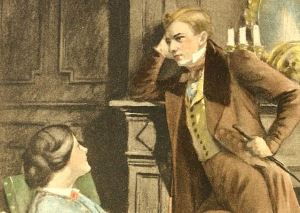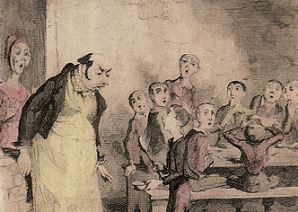12 Great Books to Read to Understand Periods in Literature

English literature has a long and illustrious history that has spawned some of the world’s most famous writers, novels, plays and poems.
You should also read…
That history can be broken down into a number of distinct literary eras, in each of which a set of characteristics or beliefs shaped the works of literature produced. Sometimes the best way of understanding different periods of literary history is to read the works that each period produced. It’s often hard to narrow down the wealth of literature springing from each era of literature to just one or two exemplary texts, but this article seeks to give you a beginner’s guide to the most prominent periods in English literary history.
Medieval Literature (500 – 1500)
The earliest works of English literature arose from the writing down of tales that had probably been around for centuries before, surviving via the oral tradition. Medieval literature tends to be split into Old English (658-1100) and Middle English (1100-1500), and these are two of the most prominent works from this period.
1. Beowulf

English Literature is said to begin with Beowulf, an epic Anglo-Saxon poem by an unknown author, thought to have been penned anywhere between the 8th and 11th centuries. It speaks of Scandinavian kings, mythical beasts and battles, and is extremely important for being the the longest surviving epic poem in Old English.
2. Geoffrey Chaucer – The Canterbury Tales
Later in the medieval period, a civil servant named Geoffrey Chaucer popularised the use of vernacular English, with the writing of his most famous work, The Canterbury Tales. More than twenty individual stories are presented in the context of a story-telling contest that takes place between a group of pilgrims who are en route to Canterbury Cathedral. Thanks to this and other works, Chaucer is often thought of as “the Father of English Literature”.
The Renaissance Era (1500 – 1670)
Stemming from the period of huge cultural advance known as the Renaissance (which began in Italy in the 13th century but took a while to reach England), this period in English literature is dominated by Elizabethan playwrights such as William Shakespeare, Christopher Marlowe and John Webster. Other notable writers include Sir Philip Sidney and Edmund Spenser. A key influence in this period was the revival in interest in classical literature, which had a profound influence not only on writing, but on art and philosophy.
3. William Shakespeare – Henry IV Parts 1 and 2

All Shakespeare is worth reading, and will help you get a sense of this period of English literature; but Henry IV, particularly Part I, is noted for being amongst the playwright’s best. Contrasting between serious and funny scenes, between solemn kings and bawdy drinking houses, it’s a superb example of the kind of contrasts Elizabethan audiences would have enjoyed. It also introduces one of Shakespeare’s greatest and most enduringly popular characters: the roguish knight, Sir John Falstaff.
4. Edmund Spenser – The Faerie Queene
A contemporary of Shakespeare, Edmund Spenser was another highly influential Elizabethan poet, who exemplified Elizabethan literature with his defining masterpiece, The Faerie Queene, an allegorical poem written in celebration of the Tudor dynasty and the reign of Elizabeth I. It’s one of the longest poems in the English language, and represents an important development in modern English verse. Her Majesty must have approved: on the strength of this poem, its author was granted a pension for life.
The Restoration (1660 – 1700)
This relatively narrow period of literary history coincides with the end of the Stuart monarchs, and is generally thought of as literature that flourished under the restored court of Charles II. It’s difficult to pin it down to exact dates, though, as literature was in a state of flux during this period, with new genres (such as the laudatory ode) springing up and responding to the political, social and economic state of play at the time; this influenced different literary genres at different times. Poetry is by far the most important genre of this period.
5. John Bunyan – The Pilgrim’s Progress

The allegorical elements of Spenser’s Faerie Queene likely influenced John Bunyan in his writing of The Pilgrim’s Progress, an important religious poem that is an allegorical treatment of Christian life, particularly the idea of personal salvation. Its protagonist, Christian, is an ‘everyman’ character, and the poem is differentiated from similar preceding texts by the simplicity of its style.
6. John Milton – Paradise Lost
More than seventy years after The Faerie Queene brought fame to Edmund Spenser, John Milton brought out another epic poem that would secure his reputation as another of the country’s finest poets. Paradise Lost, more than ten thousand lines in length, tells the Biblical story of the Fall of Man, and it’s an achievement made all the more impressive by the fact that it was dictated in its entirety, Milton having gone blind some years before he wrote it. Though Paradise Lost isn’t archetypal Restoration literature, and Milton is studied separately from other Restoration literature, this is certainly one of the most famous and influential works that sprung from this period.
The Age of Enlightenment (1700 – 1800)

The Age of Enlightenment, sometimes referred to as the Age of Reason, was a cultural movement led by philosophers such as Francis Bacon and René Descartes. It was characterised by a scientific, rational approach to the issues of the day, challenging prevailing beliefs, which had a religious basis. The movement advocated the logical working out of problems, the use of empirical evidence to support beliefs, and the rejection of superstition. Isaac Newton and Mozart are two of the famous names this era spawned.
7. Alexander Pope – The Rape of the Lock
Based on an incident said to have been described to Pope by a friend, The Rape of the Lock is his most famous poem. It’s a witty satire of England’s ruling classes, written in the style of the classical heroic epics (such as the works of Homer) that he also devoted his time to translating. The work is an important example of satire during this period (of which Jonathan Swift’s A Modest Proposal is also an excellent example), the aim of which was to poke fun at society’s failings and corruption, particularly when contrasted with the prevailing ideals.
The Romantic Period (1798 – 1870)
The Romantic period was a response to the major social change taking place in England at the time, with the Industrial Revolution seeing a move from countryside to town, and the advent of polluted, overcrowded industrial cities. The Romantic period was also a reaction against the thoughts and ideals of the Age of Enlightenment, in which poets in particular rejected the scientific rationalisation of nature.
8. William Wordsworth – Lyrical Ballads

William Wordsworth was one of a group of poets whose work exemplifies Romanticism, and his poems, many of which were written at his home in the Lake District, are some of the finest examples of Romantic literature. The Lyrical Ballads was a collection of poems mostly by Wordsworth, with a few contributed by his friend, Samuel Taylor Coleridge. Though the response to the collection at the time of its publication was underwhelming, it is now seen as an important development in English literature because the simpler language used – a reaction against the florid, overly intellectual language of 18th century poetry – made the poems accessible to anybody. This was also an acknowledgement of the fact that human emotion is a universal experience, whether rich or poor – an idea also reflected in the title of the collection and the use of the ballad form, which came from a long tradition of oral storytelling beloved of the poor.
Transcendental Movement (1830 – 1860)
While the likes of Wordsworth, Coleridge and Shelley dominated the Romantic scene here in England, another movement was developing over in America, where Romanticism influenced New England Transcendentalism. Followers of this movement believed in the innate goodness of the individual and of nature, but also that the individual is prone to corruption by society and its organised religion and politics. Like Romanticism, Transcendentalism reacted against rationalisation and advocated the power of inherent human spirituality.
9. Louisa May Alcott – Little Women

The Transcendentalist writer of whom most British people will have heard is Louisa May Alcott, author of the much-loved Little Women series. Her father, Amos Bronson Alcott, was a prominent figure in the movement, and his ideas shaped Alcott’s education and upbringing, making the movement an important backdrop to her literary career. Her family and its transcendental thinking formed the inspiration for Little Women – the character of Jo being a loose portrayal of Alcott herself. The novel is still a childhood staple in homes in the USA and Britain alike.
Literary Realism (1820-1920)
Literary realism began in France in the mid-19th century, though a move towards realism had begun earlier; Jane Austen’s novels are part of the transition. Its focus was on realistic depictions of contemporary life and society, including realistic details of day-to-day life – the kind of scenes previously shunned in favour of the idealised subjects of the Romantics.
10. George Eliot – Middlemarch

The true masterpiece of this period is George Eliot’s Middlemarch, its realism evident even from its subtitle: “A Study of Provincial Life”. The Middlemarch of the novel’s title is a fictional Midlands town populated by the many characters whose lives intermingle in a series of masterfully woven plotlines. The realistic details with which Eliot narrates her characters’ problems and their reactions to the real-life issues of the day (such as the development of the railways) are what makes the novel so impressive, earning it high praise from literary critics, some of whom have described it as the greatest of all English novels.
Victorian Literature (1837 – 1901)
The reign of Queen Victoria saw the novel come to the fore as the leading literary genre, and it was a period that saw the emergence of some of the country’s most famous writers, including Charles Dickens, Thomas Hardy, William Thackeray and the Bronte sisters. Poetry was still a prominent literary genre, with Browning and Tennyson two of the most famous Victorian poets; but this form was far less significant than it had been during the Romantic period. Later in the Victorian period we see drama emerge as a significant genre again for the first time since the Renaissance, with Gilbert and Sullivan’s comic operas, and the plays of George Bernard Shaw and Oscar Wilde.
11. Charles Dickens – Oliver Twist

Victorian novelist Charles Dickens is one of the most famous of all English authors, and his novels are often seen as the archetypal Victorian novels. They’ve been so influential that the term “Dickensian” is often used to describe anything reminiscent of his novels, in particular the atmosphere conjured up in his tales of young street urchins living in urban poverty in grim Victorian London. The atmosphere of one of his most famous novels, Oliver Twist, is a good example of this. It tells the tale of a young orphan, who’s living in appalling conditions in a workhouse before he’s sent to live with an undertaker – from whom he escapes and goes on to join a group of juvenile pickpockets. It speaks powerfully about the treatment of orphans in Victorian London, and is also a good example of Dickens’ superb characterisation – notably the character of Fagin, ringleader of the pickpockets.
Modernism (1901-1939)
Just as previous literary movements had rebelled against the attitudes of those that had gone before them, so literary modernism reacted against the conservative attitudes of the Victorian period; the First World War was also a key influence. An important characteristic of modernism is self-consciousness, which saw a spate of literary experimentation; the stream-of-consciousness novel was one such innovation.
12. James Joyce – Ulysses

In James Joyce’s Ulysses, the idea of stream-of-consciousness was taken to the extreme in a novel described as “a demonstration and summation of the entire [Modernist] movement”. In a way, it’s a modern retelling of Homer’s The Odyssey, based on the experiences of its protagonist throughout the course of a day in Dublin. The novel broke new ground in many ways, but its most famous characteristic is its use of a different literary genre or experiment for each chapter; one, for example, has no punctuation, while another is written as though it were a play.
Post-modernism (post-World War Two to the present)
After Modernism came Postmodernism, which is harder to define than the other periods we’ve discussed in this article, because there’s little agreement about what it means. Postmodernism can be said to react to Modernist ideas, introducing new concepts such as the unreliable narrator and pastiche. Well-known Postmodern novels include Joseph Heller’s Catch-22 and Sylvia Plath’s The Bell Jar.
